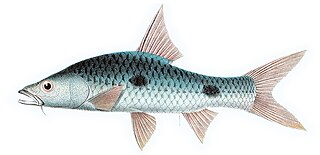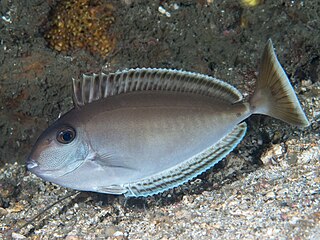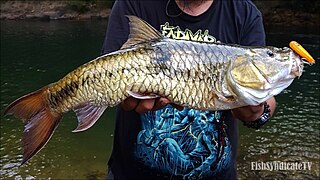
Herring are various species of forage fish, belonging to the order Clupeiformes.

Hampala is a genus of freshwater ray-finned fish belonging to the family Cyprinidae, the family which includes the carps, barbs and related fishes. The fishies in this genus are found in South-East Asia.
Barbodes clemensi is an extinct species of cyprinid endemic to Lake Lanao in Mindanao, the Philippines. It was one of the several species of fish in the Philippines known as bagangan. This species can reach a length of 23.5 centimetres (9.3 in) TL.
Barbodes cataractae is a species of cyprinid endemic to the Philippines where it is known from the Cascade River and the brackish waters of Murcielagos Bay in Mindanao. This species is commercially important.

Barbodes hemictenus is a species of cyprinid fish endemic to the island of Mindoro in the Philippines. It is only known to occur in the Sabaan, Mamboc and Baco rivers and Lake Naujan.
Barbodes manguaoensis is a species of cyprinid fish endemic to Lake Manguao in Palawan, the Philippines. This species can reach a length of 14 centimetres (5.5 in) TL.
The evergreen forest warbler or Cameroon scrub-warbler is a grass warbler species in the family Locustellidae. It was formerly included in the "Old World warbler" assemblage.

The white-tailed warbler is a species of bird in the family Cisticolidae, the only species of the genus Poliolais. It is native to the Western High Plateau and Bioko.

Naso lopezi, the elongated unicornfish, slender unicornfish or Lopez' unicornfish, is a species of marine ray-finned fish belonging to the family Acanthuridae, the surgeon fishes, unicornfishes and tangs. This species is found in the western Pacific Ocean.

Barbodes tumba is a species of cyprinid fish endemic to Mindanao, Philippines where it is found in Lake Lanao and associated water systems. This species can reach a length of 12.9 centimetres (5.1 in) SL.
Cyclocheilichthys schoppeae is a species of cyprinid fish in the genus Cyclocheilichthys from the north of Palawan in the Philippines.
Barbodes palata is an extinct species of cyprinid fish endemic to Lake Lanao, Mindanao, the Philippines. This species reached a length of 14 centimetres (5.5 in) TL. It was a commercially important species to the local peoples.
Hampala dispar, also known as the eye-spot barb or the spotted hampala barb, is a southeast Asian species of cyprinid, endemic to the basin of the Mekong. It is found in Thailand, Laos and Cambodia.

Hampala macrolepidota, the hampala barb, is a relatively large southeast Asian species of cyprinid from the Mekong and Chao Phraya basins, as well as Peninsular Malaysia and the Greater Sundas. It prefers running rivers and streams, but can be seen in most freshwater habitats except torrents, small creeks and shallow swamps. This predatory species reaches up to 70 cm (2.3 ft) in length and it is common at half that size.
Hampala salweenensis is a southeast Asian species of cyprinid, endemic to the basin of the Salween in Thailand and Myanmar. It reaches a length of 30 cm.

Hampala ampalong is a species of freshwater ray-finned fish belonging to the family Cyprinidae, the family which includes the carps, barbs and related fishes. This species is found in Sumatra and western Borneo, and has a maximum total length of 15.5 centimetres (6.1 in).
Hampala bimaculata is a species of freshwater ray-finned fish belonging to the family Cyprinidae, the family which includes the carps, barbs and related fishes. This species is found in Borneo and has a maximum total length of 50 centimetres (20 in).

Hampala sabana is a species of cyprinid in the genus Hampala that is native to Malaysia
Liolaemus lopezi is a species of lizard in the family Iguanidae. It is found in Chile, and more recently, El Salvador.








